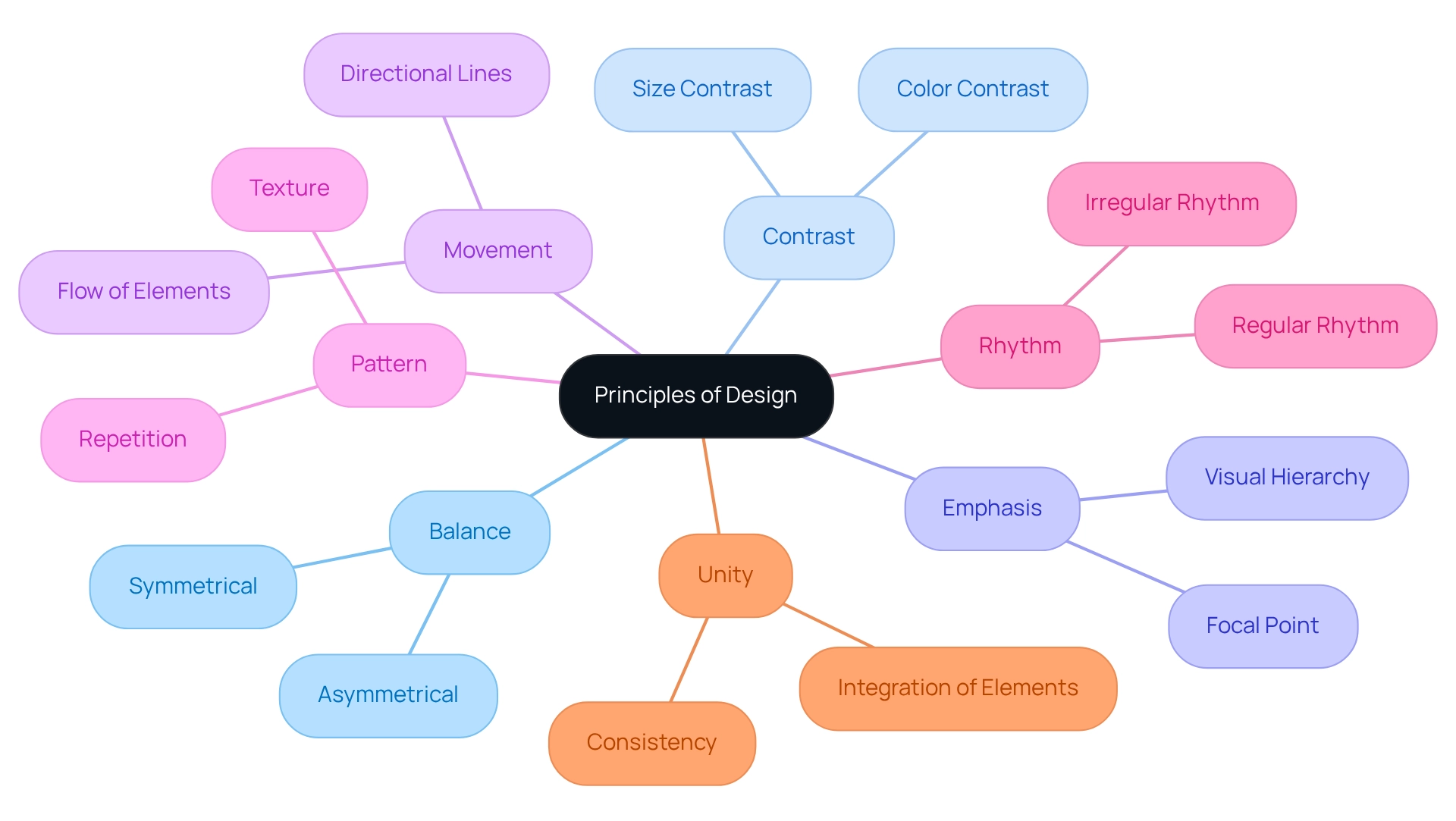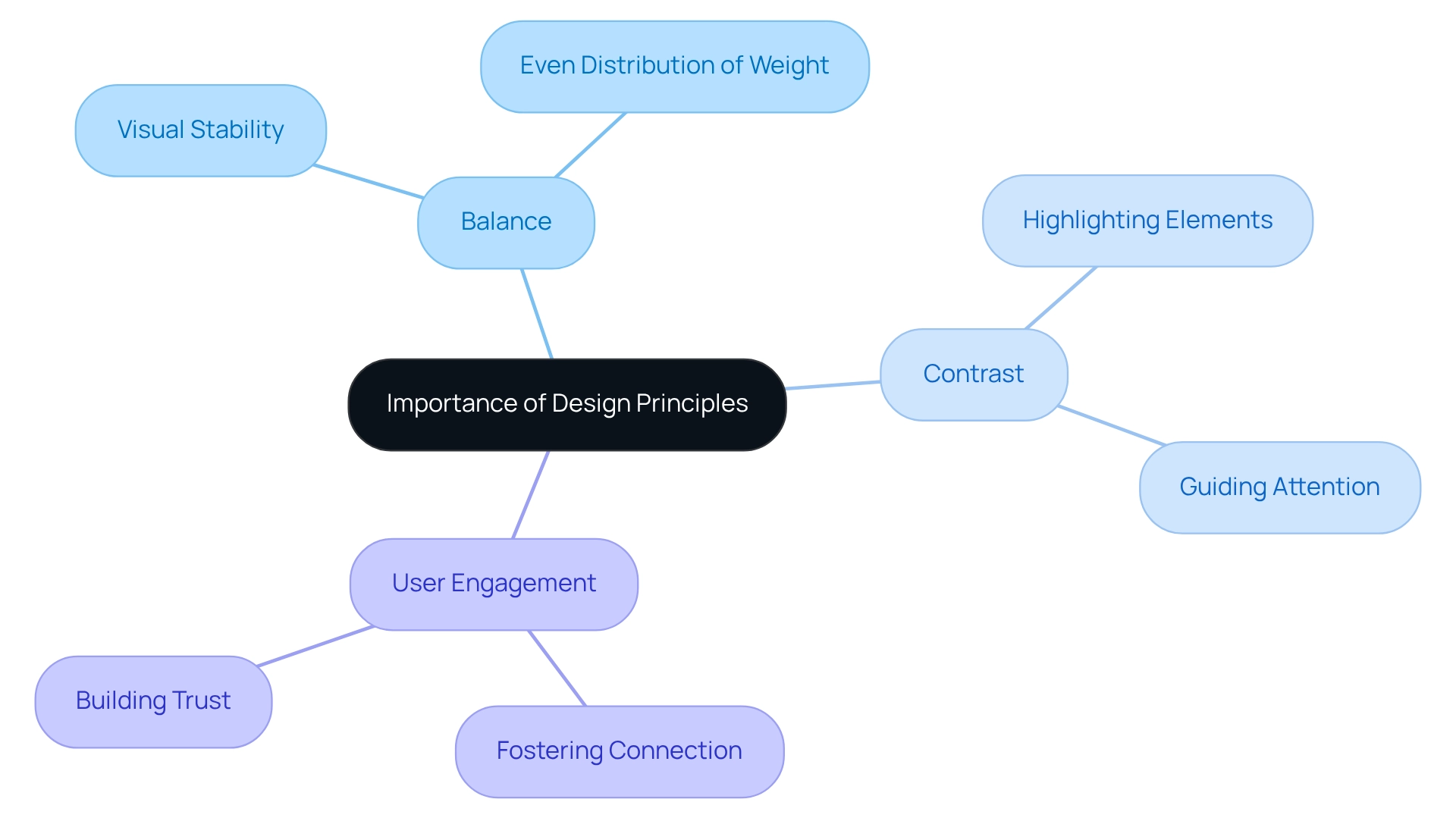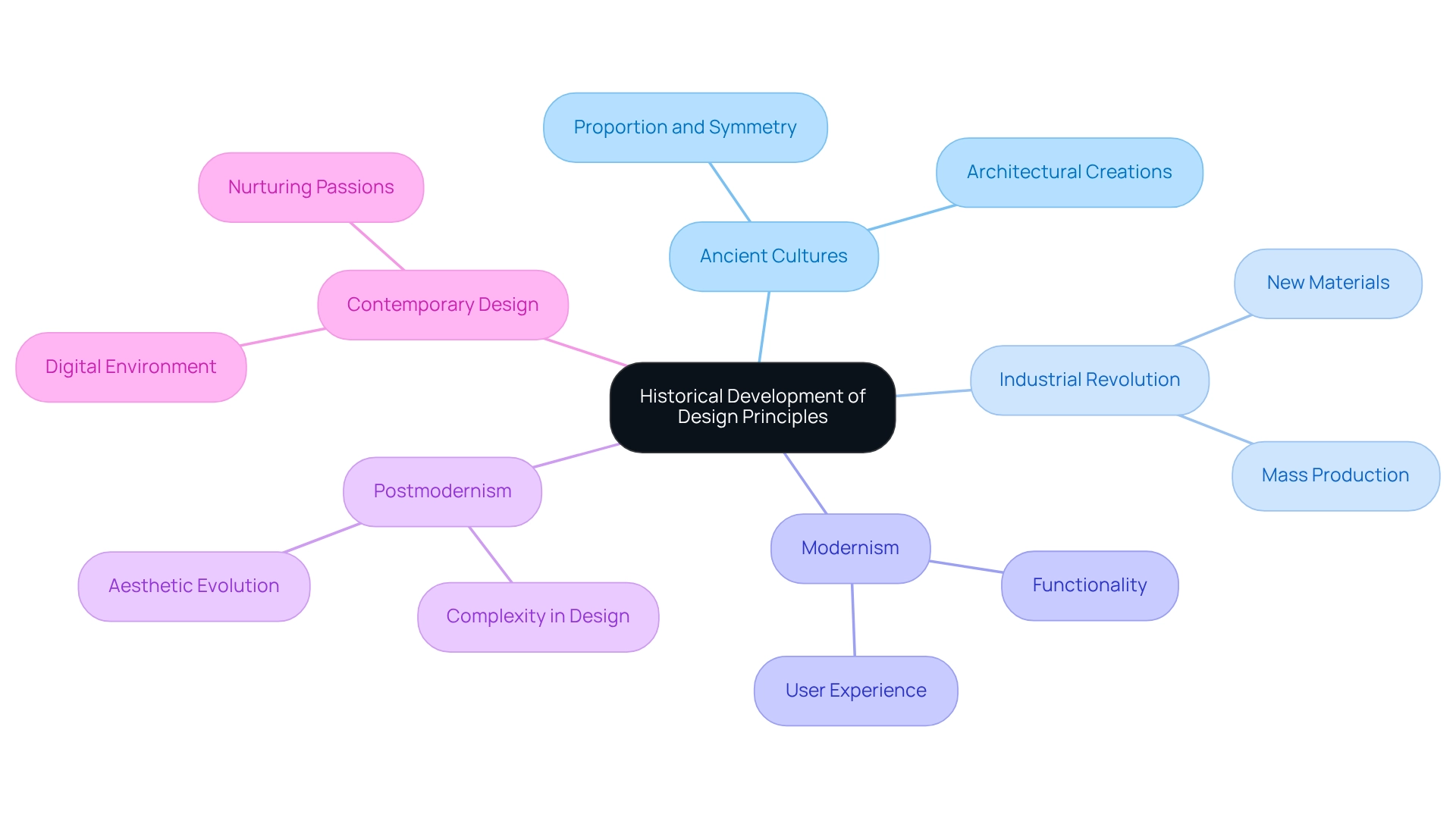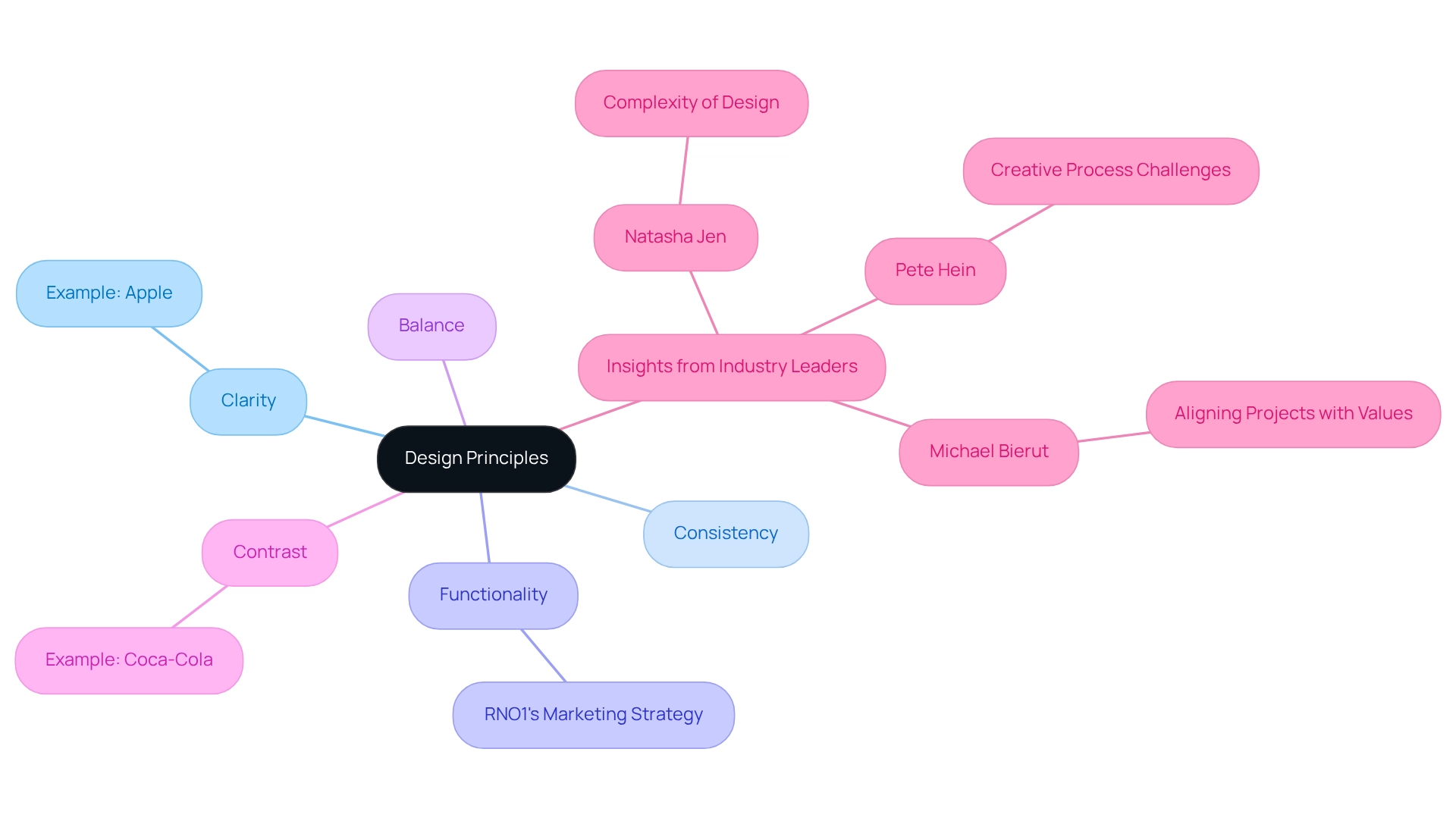Overview
In the world of design, many face the challenge of creating compositions that are not only visually appealing but also functional. This struggle can often lead to frustration, as the importance of design principles like balance, contrast, and clarity cannot be overstated. These elements are crucial in guiding effective design, yet they can sometimes feel overwhelming.
By exploring how successful brands like Apple and Coca-Cola utilize these principles, we can see how they enhance user experience and strengthen brand identity. Understanding these concepts can empower you to create designs that resonate deeply with your audience, fostering a connection that is both meaningful and impactful.
Remember, you are not alone in this journey—embracing these principles can lead to transformative results in your design endeavors.
Introduction
In a world where visual communication can determine the success of brands, many founders face the daunting challenge of standing out. It’s not just about aesthetics; it’s about creating meaningful connections through design. The principles of design are not merely guidelines; they are the foundation that enhances both functionality and user experience.
From the ancient Greeks' focus on proportion to today’s digital landscape that prioritizes user-centered design, the evolution of these principles tells a story of creativity and innovation. As you strive to engage your audience and build loyalty, remember that applying these principles can transform ordinary visuals into compelling narratives that truly resonate.
This exploration invites you to delve into the essence of design principles, their historical significance, and how they play a critical role in crafting impactful visual identities that can shine in today’s competitive environment.
Define the Principle of Design
In the world of design, many face the challenge of creating visually compelling compositions. The essential rules that govern the arrangement and organization of visual components can often feel overwhelming. Concepts such as balance, contrast, emphasis, movement, pattern, rhythm, and unity are crucial, yet they can lead to frustration when trying to achieve an appealing and practical outcome.
At RNO1, we understand these struggles, and we believe that every interaction should reflect a commitment to meaningful creativity. Our focus on aesthetics is not just a principle; it’s a nurturing approach that guides our designers. By utilizing balance to create harmony, contrast to highlight key elements, and unity as a guiding principle, we craft works that resonate deeply, effectively conveying messages and engaging audiences.
This dedication to aesthetic guidelines is not merely about design; it enhances brand marketability through our Return On Design & Digital (RODD) strategies. We invite you to share your experiences and challenges with us, as we are here to support you in navigating the complexities of design. Together, we can create something truly beautiful and impactful.

Contextualize the Importance of Design Principles
Design guidelines are crucial because they offer a supportive framework for making design decisions that truly enhance visual communication. They empower designers to create compositions that are not only visually appealing but also functional and user-friendly. Many of us have faced the frustration of unclear designs that fail to connect with their audience. This can lead to missed opportunities and disengagement.
For instance, consider the principle of balance; it ensures visual weight is distributed evenly, fostering a sense of stability that we all crave. Similarly, contrast plays a vital role in highlighting important elements, gently guiding the viewer's attention where it matters most.
In the realm of branding, embracing these concepts can profoundly impact how a brand is perceived, nurturing customer engagement and loyalty. By understanding and implementing these design principles, we can create experiences that resonate deeply with our audience, fostering a sense of connection and trust.

Trace the Historical Development of Design Principles
The historical evolution of creative guidelines presents a relatable challenge, tracing back to ancient cultures where artists and architects established essential ideas. For instance, the Greeks exemplified the principles of design, emphasizing proportion and symmetry in their architectural creations—principles that continue to resonate in modern practices. As the poet Bukowski wisely noted, 'Find what you love, and let it kill you,' a reminder of the deep passion that fuels our creativity. This passion aligns with the belief that creation is about harmonizing the world with our dreams and aspirations.
However, the Industrial Revolution marked a significant turning point, introducing new materials and technologies that demanded adjustments to these concepts for mass production. As aesthetics evolved, movements like Modernism and Postmodernism emerged, placing greater emphasis on functionality and user experience. Today, in our digital environment, these foundational concepts remain vital, continuously adapting to address the complexities of user-focused creation and the ever-changing demands of contemporary technology.
As we navigate these challenges together, it's essential to remember that the journey of creativity is not just about the end product, but about nurturing our passions and aspirations along the way.

Identify Key Characteristics and Examples of Design Principles
In the world of design, many founders grapple with the challenge of ensuring their message resonates clearly with their audience. The principles of design, including clarity, consistency, and functionality, play a crucial role in this process. Clarity ensures that your message is easily understood, while consistency fosters a cohesive identity across various platforms. Functionality emphasizes usability, making certain that your creations fulfill their intended purpose effectively. RNO1’s innovative marketing strategy exemplifies this functionality, accelerating the speed to market for new therapies and enhancing cost efficiency, all while providing ongoing support for organizations navigating their digital journeys.
Achieving balance in design can be approached through both symmetrical and asymmetrical arrangements, each tailored to evoke specific emotional responses. Take, for example, Apple’s minimalist product style. It beautifully illustrates clarity and user experience, creating a seamless interaction between the user and the product. In contrast, Coca-Cola’s marketing effectively employs contrast and repetition, reinforcing its identity through vibrant colors and familiar imagery.
The intricacy of creation is further highlighted by industry leaders like Natasha Jen, who passionately emphasizes that creation involves layers of creativity and problem-solving. This perspective encourages us as designers to embrace the complexities of our craft, fostering innovative solutions that resonate deeply with our audiences. Architect Pete Hein observes that the creative process often entails wrestling with obstacles and ambiguities, which can lead to remarkable outcomes. By understanding and implementing these concepts, we can create captivating visual messages that not only attract attention but also foster engagement and loyalty.
Michael Bierut wisely advises designers to pursue projects that align with their values, enhancing clarity and consistency in their work. Statistics reveal that brands leveraging effective design principles, like those offered by RNO1, experience a significant increase in customer retention and satisfaction. This underscores the importance of thoughtful design in modern branding strategies. Together, let’s explore how embracing these principles can nurture your brand’s journey and foster a supportive community around your vision.

Conclusion
The exploration of design principles highlights a crucial challenge in visual communication: how to effectively convey messages that resonate with audiences. By understanding and applying principles like balance, contrast, and unity, designers can craft compositions that are not only beautiful but also functional and user-friendly. These principles form a supportive framework for making informed design decisions, ultimately enhancing brand perception and fostering deeper connections with customers.
Reflecting on the historical development of these principles reveals their journey from ancient civilizations to today’s digital landscape. This evolution underscores their adaptability to technological advancements and the changing needs of users. The focus on clarity, consistency, and functionality ensures that design remains relevant and impactful, guiding brands in their quest to connect meaningfully with their audiences.
In closing, applying design principles is essential for creating compelling visual identities that stand out in today’s competitive environment. As brands strive to differentiate themselves, embracing these principles can transform their messaging and nurture stronger connections with their audience. Committing to thoughtful design transcends mere aesthetics; it is a strategic choice that can significantly enhance marketability and cultivate customer loyalty. Together, let’s embrace the power of design to create a brighter future for our brands and communities.
Frequently Asked Questions
What are the essential rules of design that can be challenging to implement?
The essential rules include balance, contrast, emphasis, movement, pattern, rhythm, and unity, which can often feel overwhelming when trying to create visually compelling compositions.
How does RNO1 approach the challenges of design?
RNO1 believes that every interaction should reflect meaningful creativity, focusing on aesthetics as a nurturing approach that guides their designers in creating harmonious and engaging works.
What role does balance play in design according to RNO1?
Balance is utilized to create harmony in design, helping to ensure that visual components are arranged in a way that is aesthetically pleasing.
How does contrast contribute to effective design?
Contrast is used to highlight key elements within a composition, making them stand out and enhancing the overall visual impact.
What is the importance of unity in design?
Unity serves as a guiding principle that helps to create a cohesive and harmonious composition, ensuring that all elements work together effectively.
How does RNO1's design philosophy enhance brand marketability?
RNO1's dedication to aesthetic guidelines enhances brand marketability through their Return On Design & Digital (RODD) strategies, which focus on creating impactful and engaging designs.
Can I share my design challenges with RNO1?
Yes, RNO1 invites individuals to share their experiences and challenges with them, as they are committed to supporting others in navigating the complexities of design.




